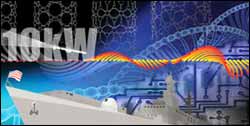Free electron laser reaches 10 kW

The Free-Electron Laser (FEL) achieved 10 kilowatts of infrared laser light, making it the most powerful tunable laser in the world.
The Free-Electron Laser (FEL), supported by the Office of Naval Research and located at the U.S. Department of Energy’s Thomas Jefferson National Accelerator Facility, achieved 10 kilowatts of infrared laser light in late July, making it the most powerful tunable laser in the world. The recently upgraded laser’s new capabilities will enhance defense and manufacturing technologies, and support advanced studies of chemistry, physics, biology, and more.
“No other laser can provide the same benefits to manufacturing, medical research, biology, and basic physics,” said ONR’s Directed Energy Program Officer, Mr. Quentin Saulter. “The Navy has chosen the FEL because it has multi-mission capabilities. Its unique, high-power and 24-hour capabilities are ideal for Department of Defense, industrial, and scientific applications.”
The FEL program began as the One-Kilowatt Demonstration FEL, which broke power records and made its mark as the world’s brightest high average power laser. It delivered 2.1 kilowatts (kW) of infrared light, more than twice it was initially designed to achieve, before it was taken offline in November 2001 for an upgrade to 10 kW. “Whenever a technology gains a factor of ten improvement in performance, the achievement opens the door to many new applications, some foreseen, and some are simply very pleasant surprises,” said Christoph Leemann, Jefferson Lab Director. “We look forward to operating this exciting new machine and carrying out the many experiments planned for it.”
The FEL provides intense beams of laser light that can be tuned to a precise wavelength, and which are more powerful than beams from a conventional laser. Conventional lasers are limited in the wavelength of light they emit by the source of the electrons (such as a gas or crystal) used within the laser. In the FEL, electrons are stripped from their atoms and then whipped up to high energies by a linear accelerator. From there, they are steered into a wiggler–a device that uses an electromagnetic field to shake the electrons, forcing them to release some of their energy in the form of photons. As in a conventional laser, the photons are bounced between two mirrors and then emitted as a coherent beam of light. However, FEL operators can adjust the wavelength of the laser’s emitted light by increasing or decreasing the energies of the electrons in the accelerator or the amount of shaking in the wiggler.
“As we cross the 10 kW milestone, our team at Jefferson Lab is grateful for the considerable support and encouragement we have received from the Navy, Air Force and our colleagues across the country,” said Fred Dylla, Jefferson Lab FEL program manager.
ONR’s Quentin Saulter manages the FEL development effort in cooperation with the Naval Sea Systems Command (NAVSEA) Directed Energy and Electric Weapons Office, headed by Captain Roger McGinnis. ONR is also funding the operation and optimization of the 10 kW FEL, and has several experiments slated to begin in early fall. A laser materials damage study will be co-funded with the Office of the Secretary of Defense High Energy Laser Joint Technology Office (HEL-JTO). In another project, scientists from the Naval Research Laboratory will study laser propagation through the atmosphere, with an eye to new laser-based shipboard defense strategies.
The Navy is also interested in the ultraviolet and terahertz light that the FEL can produce at world-record powers. The Navy intends on using the lessons learned from the development of the 10 kW FEL to begin design and construction of a 100 kW FEL over the next four years. Eventually, the Navy plans on moving the 100 kW laser to an over water test site, and scaling the power up to megawatt levels.
Media Contact
All latest news from the category: Power and Electrical Engineering
This topic covers issues related to energy generation, conversion, transportation and consumption and how the industry is addressing the challenge of energy efficiency in general.
innovations-report provides in-depth and informative reports and articles on subjects ranging from wind energy, fuel cell technology, solar energy, geothermal energy, petroleum, gas, nuclear engineering, alternative energy and energy efficiency to fusion, hydrogen and superconductor technologies.
Newest articles

NASA: Mystery of life’s handedness deepens
The mystery of why life uses molecules with specific orientations has deepened with a NASA-funded discovery that RNA — a key molecule thought to have potentially held the instructions for…

What are the effects of historic lithium mining on water quality?
Study reveals low levels of common contaminants but high levels of other elements in waters associated with an abandoned lithium mine. Lithium ore and mining waste from a historic lithium…

Quantum-inspired design boosts efficiency of heat-to-electricity conversion
Rice engineers take unconventional route to improving thermophotovoltaic systems. Researchers at Rice University have found a new way to improve a key element of thermophotovoltaic (TPV) systems, which convert heat…



